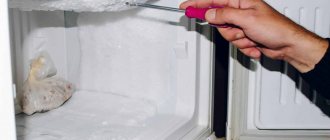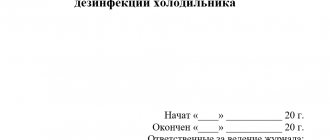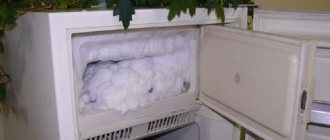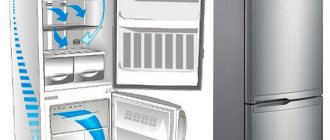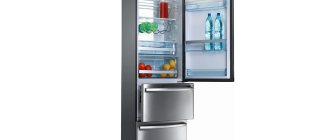Home/Home Tips/How often should you clean and defrost your refrigerator?
The refrigerator is an important element of any kitchen. Currently, the range of refrigeration chambers is very wide and varied. Each of the refrigerators on the market will differ in its characteristics, power, and design. However, even expensive ones need cleaning.
Features of refrigerators
Modern technologies produce equipment that is as convenient and comfortable to use as possible. This also applies to refrigerators. Modern models no longer need frequent defrosting and cleaning, as today they have a self-thawing function. In other words, ice no longer accumulates in the freezer. This function saves time and effort and makes life easier for housewives.
How often should you clean your refrigerator?
Timely cleaning is necessary for any refrigerator; cleaning and washing should not involve defrosting the ice. A clean refrigerator is the key to good health and well-being. Hygiene and disinfection in the place where food is stored allows food to remain fresh longer and protects against harmful microorganisms entering the body with food.
After all, despite the fact that the temperature in the refrigerator is low, this does not stop the growth of bacteria and microbes, but only slows it down. There are types of mold that live even at -4 °C. And when fungal enzymes enter the body, they disrupt metabolism and destroy the protection of cell membranes, making them defenseless against infections. Therefore, regular and proper cleaning of the refrigerator and compliance with storage standards for the contents is a must for a good housewife who cares about the health of her loved ones and herself.
No Frost - prevents condensation from forming by moving air in the chamber using a fan. Drip system - when the condenser automatically works so that moisture accumulates on the air cooler, turns into ice crystals and periodically thaws, flowing into a container for evaporation.
How often should you completely clean your refrigerator? It is believed that once every two weeks is optimal for maintaining sanitary standards. But it’s worth keeping the refrigerator compartment clean all the time:
- Clean up crumbs, spills and other stains.
- Wash external surfaces, especially areas that are frequently touched with hands.
- Place only clean dishes on the shelves.
- Do not keep raw meat, fish, berries in bags, but transfer them to a bowl so that there are no traces or drips left.
- Place vegetables in the refrigerator washed and dried.
- Store products in separate closed containers or under cling film. Especially if the refrigerator has a no-frost system. Immediately get rid of expired or spoiled ones.
This way, there is less pollution, and unpleasant odors do not permeate the plastic. Then “general” cleaning will be easier and faster.
Manufacturers recommend that No Frost refrigerators be completely defrosted once a year for prevention, while modern ones with a drip auto-defrost system should be defrosted every 3-6 months, or according to the instructions.
How does a refrigerator self-defrost?
There are three types of systems.
- Air system. Defrosting occurs due to the fact that the fan runs continuously, creating a constant air flow.
- Drip system. The rear surface of the freezer compartment is cooled. This prevents glaciation from forming.
- Airborne droplet system. This type of refrigerator does not require defrosting, which saves time on caring for it. It can be defrosted no more than once every 6 months.
Those refrigerators that use modern advanced technologies do not need to be defrosted, since frost and ice do not form.
If the refrigerator compartment is less modern, then defrosting once every three to four months would be optimal.
How often you defrost your refrigerator determines how long it will last and perform its functions efficiently.
How to properly clean a refrigerator?
A clean refrigerator allows it to work better and keep food fresh longer. We will help you figure out how often and what to clean your refrigerator inside and out.
How often should you clean your refrigerator?
The refrigerator should be wiped down at least once a week, inside to remove food debris and outside to remove fingerprints and accumulated dirt.
It is recommended to carry out a thorough cleaning of the refrigerator with defrosting at least once a month. This will allow you to avoid the formation of a large layer of ice, which reduces its efficiency.
If you are wondering whether it is possible to clean your refrigerator less often, yes, you can. If your refrigerator is equipped with the NoFrost system, then you can wash and defrost the refrigerator once every three months.
Preparing to wash the refrigerator
- First, prepare the necessary equipment: rubber gloves, a kitchen sponge, a clean cloth.
- Sort through the food in the refrigerator and freezer. You may find a two-week old soup or a jar that has been sitting around for over a year - throw it away without regret. Remove all the necessary products from the refrigerator.
- Set the refrigerator thermostat to zero and unplug the refrigerator.
- Remove all shelves, containers and racks and soak them in warm soapy water for 20 minutes.
- Cover the floor next to the refrigerator with a cloth to protect it from moisture.
Next we start defrosting. You can let the refrigerator defrost on its own, but it will take you more than 2 hours. We will tell you several ways to speed up this process:
- Pour boiling water into a saucepan or plate and place in your refrigerator and freezer. Thanks to the steam from the water, the refrigerator will slowly begin to thaw. Change the water when it becomes warm and repeat the procedure.
- Use a hair dryer. Direct a stream of hot air onto the ice-covered surface. Be careful not to let water get on your hair dryer. We must warn you that such defrosting will take a very long time and the hair dryer may not withstand such a long operation. In this regard, you can only use the hair dryer for a short amount of time, giving it a break!
How to clean the refrigerator?
You can clean your refrigerator using various home remedies. We will tell you what tools may be useful to you.
- Soap solution. Grate the soap and dilute it in warm water in a ratio of 1:10. Using this mixture you can wash seals and rubber bands in the refrigerator.
- Lemon juice. Dissolve 2 tablespoons in 0.5 liters of water. This solution is effective against unpleasant odors. In addition to this, you can use activated carbon for odor. Just leave a couple of charcoal tablets in the refrigerator overnight.
- Soda. Mix 2 tablespoons of baking soda in half a liter of water. This mixture copes with bacteria twice as well. You can use it to wipe the inside walls, grilles and shelves of your refrigerator.
- Ammonia. Mix 30 ml of ammonia and 300 ml of clean water. If you are interested in how to clean the inside of the refrigerator after defrosting, then this is the best option.
- Hydrogen peroxide. If there are yellow stains on your refrigerator, you can try to wash them off with peroxide. Apply the solution to a cotton pad and wipe the surface at least 3 times.
So we figured out how to clean a refrigerator at home. Use one or a combination of these products and your refrigerator will sparkle clean.
When washing the refrigerator, do not forget to wash all its parts, namely: the condenser, drain hole, drainage, walls and seal.
How and with what to clean the outside of the refrigerator?
The outer surface of the refrigerator is exposed to pollution no less than the inner one. Stains on the outside can appear during cooking or from proximity to the stove or sink. In addition, over time, dust settles on the surface of the refrigerator, which is not always easy to wipe off.
To clean your refrigerator, you can:
- Use household chemicals. Since the outside surface of the refrigerator does not come into contact with food, you can use an alkaline or neutral household detergent. For example, dishwashing detergent. Apply a couple of drops of the product to a dampened cloth and wipe the outside of the refrigerator. Important: do not use the hard side of the sponge or steel wool!
- Use glass cleaner. Quite often you can see fingerprints on the surface of the refrigerator. This type of stain can be easily removed using regular glass cleaner.
- Use dry cloths. To prevent streaks from remaining on the surface, after wiping, walk with a dry microfiber cloth over the outside of the refrigerator.
- If you notice very stubborn stains on your refrigerator, you can use a small amount of toothpaste. Apply it to dirt, wait 10 minutes and wipe off with the soft side of the sponge.
In this article, we told you how to properly clean your refrigerator inside and out. If you don't neglect to regularly clean your refrigerator, you won't have to spend hours scrubbing stubborn stains from the surface of the refrigerator.
React Like Love Haha Wow Sadness Angry
How to properly defrost a refrigerator compartment
What to do with frozen food
Before you begin the defrosting process itself, the freezer should be emptied of food. There are different ways to solve the issue:
- ask your neighbor to temporarily place your food in his refrigerator;
- use special containers with refrigerant;
- pre-freeze several plastic bottles and place them in an airtight place along with frozen foods;
- in winter, simply place it on the balcony or hang it from a hook near the window opening.
Inside the refrigerator
Now is the time for the hardest part. First of all, warn everyone that you will be very busy, and then close your social media pages. It’s better to put your phone aside too. You can leave the computer turned on with instructions on the screen.
1. If it is winter, move all the products to the balcony, where they will be exposed to low temperatures. If it's summer, you should eat most of the food first or buy a thermal bag in which you can place food while you clean the refrigerator so that it doesn't spoil. Spoiled food should be thrown away without pity, otherwise your hard work will be in vain.
2. Remove the shelves from the empty refrigerator and place them in the bathtub. You cannot wash them immediately with hot water, otherwise the glass may crack due to a sharp temperature change. So we'll leave the shelves for last. We return to the refrigerator, look at it sadly, take a deep breath and exhale sharply. That's it, it's time to start.
3. Wash the inside of the refrigerator with soap and water. You can also use dishwashing detergent and wipe with napkins or a sponge. If something cannot be washed off, remove the stain with vinegar or a soda solution (1 tablespoon per liter of water). You cannot use powders or other chemicals, because the remaining particles of these substances can then enter the body along with food. An exception is special products for cleaning the refrigerator.
4. When the refrigerator looks clean, you should go through it again with a damp sponge or napkins. Then wipe dry and leave to air. At this time we return to the shelves that are waiting in the bath. Now wash them with dishwashing detergent and a sponge, using warm water. We wipe clean shelves and then smell them - there should be no suspicious smell. After this, you can return the dry shelves to the dry refrigerator. Next we return the food.
5. It is recommended to wash the inside of the refrigerator once every six months. Of course, if there is an unpleasant odor or you yourself see that the device needs to be washed, there is no need to wait until the scheduled day.
Photo: pixabay.com
Cleaning steps
Cleaning can begin after all the ice in the refrigerator has thawed. Usually, to wash a refrigerator, you use regular dishwashing detergent, a container of warm water and a sponge. It is not recommended to use acids (citric, acetic) - this cleaning method can damage the surface. After treating the surface with detergent, the refrigerator is rinsed with clean water.
When finished, wipe the surface dry. Connect the cord to the power source. Once a certain temperature has been reached, food can be placed in the chamber.
AlinaAuthor of the article
Did you like the article?
Share with your friends:
How to properly clean and care for a refrigerator?
At the beginning of any process, you need to prepare your “workplace”, providing yourself with all the necessary tools. After all, then the washing itself will be quick and uncomplicated.
Arm yourself with the following tools:
- container with warm water. A plastic bucket or basin will do;
- store-bought or folk remedy;
- sponge;
- microfiber cloth;
- clean cotton towel;
- rubber gloves to protect your hands.
Algorithm of actions
- When performing general cleaning in the refrigerator, be sure to unplug it! Then you should remove all the contents of the refrigerator and sort it: put fresh food in a cool place, and put slightly spoiled food in the trash.
- If possible, disassemble all shelves, trays and fasteners. This will make it more convenient to wash, save a lot of time, and also carry out a more thorough inspection. Moreover, all parts are much easier to clean under the shower.
- After washing, the refrigerator must be left for 1-1.5 hours to dry in the summer, and for 2-3 in the winter. If you have wiped the equipment well with a dry towel, then airing for 30-40 minutes is enough.
- You can put the shelves back only after they have completely dried. And you can upload products back only after connecting to the network. And not immediately, but after 40-60 minutes of work.
Do not forget to ventilate the equipment before turning it on.
Recommendations for the operation of refrigeration equipment
- All food in the refrigerator should be stored in closed containers or bags. And always remember about food proximity - different products should not come into contact with each other.
- As a small life hack, cover the boxes for storing vegetables and fruits with polyethylene, foil or parchment paper to avoid severe contamination.
- Periodically wipe the refrigerator handle with special wipes, since it is where a large number of harmful microorganisms are concentrated that can get on food.
- Before you go shopping, check the contents of your refrigerator and throw away any spoiled or out-of-fresh food. When adding new ones, they are unlikely to be used for their intended purpose, but will create a favorable atmosphere for the development of bacteria and the appearance of an unpleasant odor.
- Food should be defrosted in deep containers so that the water draining from it after defrosting does not spill over the edge onto other foods.
- Try to eat foods that were previously in the refrigerator first. Remove moldy or spoiled food from the refrigerator immediately.
As you can see, you can cope with unpleasant odors and dirt with the help of inexpensive improvised means, which are sure to be in every kitchen. But the most important rule is to remove everything on time and prevent food from spoiling inside the refrigerator.
You can also use home remedies to clean your refrigerator.
We are talking, first of all, about such products as soda, vinegar and lemon. By the way, the same means can remove unpleasant odors from the refrigerator.
For example, in order to wash the refrigerator with vinegar, you need to dilute table vinegar in a container for washing. We dilute vinegar in the same proportion with warm water, for example, a glass of table vinegar per glass of warm water. Using this solution, use a sponge or soft cloth to wash all the internal surfaces of the refrigerator. If necessary, rinse several times. After this, as when using other means, rinse the refrigerator with clean water.
When using vinegar, do not forget that vinegar is, first of all, an acid, so even despite its low concentration, use rubber gloves when working, and try to prevent this solution from getting into your stomach.
Cleaning with regular table soda will be no less effective for caring for your refrigerator. The washing solution is made in the following proportion: 2 tablespoons of soda (small heaped) mixed with half a liter of warm water in a container for cleaning the house. Stir thoroughly until the soda is completely dissolved.
Use this solution to clean the interior and exterior of the refrigerator. If necessary, rinse several times. After this, wash the refrigerator with a well-absorbent cloth, rinsed in clean water.
In the same way, you can wash the refrigerator using a solution mixed with lemon juice. Mix two tablespoons of lemon juice, squeezed from fresh lemon (you can simply squeeze it with your hands), with half a liter of warm water. Mix the resulting solution a little, moisten a sponge or cloth in it, and wash all parts of the refrigeration unit.
When washing the refrigerator using any of the above products, the greatest emphasis should be placed on food stains, scrubbing them thoroughly. It is from such stains, especially old ones and ingrained into the walls of our refrigeration unit, that an unpleasant odor appears in the refrigerator.
How to clean a refrigerator without defrosting
There are situations when the refrigerator needs to be washed without defrosting it.
For example, if you accidentally spilled soup, or jam leaked out, or an egg broke. Yes, there could be many reasons. Dont be upset. In such a situation, the refrigerator can be washed without disconnecting it from the electricity, and of course without defrosting it.
In this case, if you can get a dirty shelf, take it out, wash it and put it back in the refrigerator.
Or, as an option, apply a small amount of detergent to a damp cloth, wipe the dirty surface, then rinse with a cloth rinsed in clean water.
If necessary, if you couldn’t wash off the dirt the first time, repeat the washing process again.
OK it's all over Now. We washed the refrigerator, both inside and outside.
May your refrigerator serve you for a long time!
Refrigerator cleaning steps
For convenience, we will divide the process of washing the refrigerator into stages, each of which I will comment in detail. Dividing washing into stages will allow you to rationally distribute your time not only when washing the refrigerator, but also when carrying out general cleaning of the kitchen.
Disconnecting the refrigerator from electricity
When washing a refrigerator, like any household appliance, we begin by disconnecting it from the electricity. This must be done. You never know what part of the refrigerator you will touch with a wet rag. And, so as not to give you an electric shock, we turn off the refrigerator.
So, the first thing to do is disconnect the refrigerator from the power supply.
We take out all the food from the refrigerator
In order to wash the inside of the refrigerator, you must remove everything from it.
We remove everything from the refrigerator, from food stored in it to jars with prepared ingredients. You also need to remove everything from the freezer.
Defrosting the refrigerator
Even refrigerators with no-frost systems must be defrosted at least once a year. And if necessary, more often. Ice also accumulates on the walls of such refrigerators, although in much smaller sizes than in conventional refrigerators.
With conventional refrigerators, everything is simpler - the need to defrost them is visible almost immediately - as soon as the ice in the freezer becomes visible, and if it also interferes with the opening and closing of the door, or interferes with getting food out, then it is time to defrost and wash the refrigerator.
Do not forget that a large amount of ice in the freezer compartment of the refrigerator or on the walls of the refrigerator itself increases the operating time of the motor - the compressor - it needs more time to work, since a large amount of ice interferes with the operation of the compressor. And since the motor-compressor runs longer, more electricity is spent, which means your energy costs will increase.
Read the link on what you can save on at home: Life hacks for housewives: what you can save on at home.
To speed up the defrosting of the refrigerator, boil water in a small saucepan and place it in the refrigerator. You need to place the pan on a stand, otherwise you risk damaging the plastic parts of the refrigerator on which the very hot pan will sit.
In no case should you chop ice frozen in the refrigerator with a knife or other sharp objects to speed up defrosting. This can easily damage the plastic parts of the refrigerator.
And do not forget, when defrosting, to periodically remove and pour out the water from the container located under the refrigerator. Water accumulates in it very quickly and, accordingly, can easily spill on the floor under the refrigerator. Also, to prevent water spills, place absorbent rags near the container.
Periodically, while your refrigerator is defrosting, you need to remove pieces of ice from it - this will allow you to spend less time collecting defrosted water.
It is also necessary to periodically collect water inside the refrigerator with a well-absorbing cloth.
We take out all the shelves from the refrigerator
While our refrigerator is defrosting, we need to remove all the internal shelves from it. You also need to remove the shelves from the refrigerator door. They need to be washed.
Before you start cleaning the plastic shelves of your refrigerator, let them sit at room temperature for a while.
If you start washing plastic shelves immediately after you take them out of the refrigerator, and even in hot water, the plastic may not only darken, but also become covered with small cracks due to temperature changes, which obviously will not add beauty to the refrigerator.
If you cannot reach some shelves due to frozen ice, do not try to remove them by force. It’s easy to break a shelf, but finding another one will be extremely unlikely.
Therefore, if the shelf cannot be reached, we wait until it defrosts, and only after that we take it out and wash it.
Refrigerator shelves, like the refrigerator itself, can be washed with regular dishwashing detergent. We thoroughly wash all the gaps near the shelves, wash away all food residues (if any), and rinse thoroughly with clean water.
After this, the shelf must be wiped with a dry, absorbent cloth.
After washing, we put all the shelves aside for now, and while our refrigerator is still defrosting, we will deal with the products that we took out of the refrigerator.
We sort out the products that are stored in the refrigerator
It is necessary to carefully sort out all the food and other supplies that you usually store in the refrigerator.
All products that have expired, and, as a rule, these are leftover sour cream, pieces of dried cheese, and the like, are different for everyone, should be thrown away.
It is also necessary to throw away all products whose appearance “does not promise much to be desired,” that is, such products are clearly no longer suitable for consumption.
We sort the rest of the products and, if necessary, pack them into new bags; we will put them back after defrosting the refrigerator and completing the internal cleaning of the refrigerator.
It is also necessary to carefully sort through all the preparations that are stored in the refrigerator. The principle is the same - if mold is visible in a jar, for example, with mushrooms, it is better to throw out the filling from this jar.
Poisoning with gifts of nature when they are improperly stored is very common.
If your “jar” supplies do not raise doubts about their edibility, the jars should be carefully wiped with a damp, but not hot, cloth.
Later, these jars will take their rightful place in your refrigerator.
Cleaning the inside of the refrigerator
As soon as the process of defrosting the refrigerator is completed, we begin to wash the inside of the refrigerator.
To do this, take out all the remaining shelves and wash them thoroughly.
After this, you need to thoroughly rinse all the internal walls and the inside of the refrigerator door with a damp cloth. If necessary, and also if there is an unpleasant odor from stagnant food in the refrigerator, you need to wash the walls using any dishwashing detergent or any kitchen cleaning product.
Try to avoid products containing chlorine, as the strong smell of this substance will take a long time to dissipate, which is unacceptable for the refrigerator.
After this, you need to thoroughly rinse the walls of the refrigerator several times with plain water, rinsing the cloth more often.
Do not allow kitchen cleaning products to remain unrinsed on the walls of the refrigerator - after you place food in the refrigerator, the remaining kitchen cleaning products may accidentally get into the food and into your stomach.
After you have washed the inside of the refrigerator, go over it with a dry cloth so that there are no wet islands left on the walls. The inside of the refrigerator should be dry.
Cleaning the outside of the refrigerator
After we have completed the process of cleaning the inside of the refrigerator, we need to wash the outside of the refrigerator as well.
To do this, you can use more active kitchen cleaning products. This is especially true for the edge of the refrigerator door and refrigerator handles - these are usually the dirtiest parts of the refrigerator.
After washing the outside, it is also worth wiping the refrigerator with a dry cloth.
Putting the internal shelves of the refrigerator in place
We have completed the refrigerator cleaning process. We put back all the shelves and shelves that we took out to wash.
Before putting the shelves back in place, make sure they are dry, or additionally wipe them with a dry cloth.
Putting food in the refrigerator
After all the shelves have been returned to their places in the refrigerator, we place the food on them.
Try to arrange foods in such a way that those foods that need to be eaten earlier are closer to the edge of the shelf and are immediately accessible when you open the refrigerator.
Turn on the refrigerator
And so, we have completed the process of washing the refrigerator, we have put all the products in their places, and now we can turn on the refrigerator.
When turning it on, you need to make sure that the motor-compressor has started, that is, it is working.
After a while, you need to look into the refrigerator to check if everything is working.
How to get rid of unpleasant smell in the refrigerator
Odor sources can include spoiled food that has been in the refrigerator for a long time, old stains from leaked food or pickles, and islands of mold that have arisen due to excessive dampness in the refrigerator. Irregular and extremely infrequent maintenance of the refrigerator can also cause an unpleasant odor.
In most cases, in order to get rid of an unpleasant odor in the refrigerator, it is enough to sort through the food items in it, remove (throw away) the spoiled ones, and wash the refrigerator using the products indicated above.
Old stains or stains with traces of mold are best washed with a vinegar solution. Acetic acid will not only disinfect your refrigeration unit, but also get rid of unpleasant odors. Solutions of baking soda and lemon juice will also work well.
When washing, do not forget to thoroughly rinse all rubber seals; they not only perfectly absorb all odors, but also contain a huge amount of odorous and harmful microbes in their cavities.
After you have washed the refrigerator, leave it to air for a while so that any remaining odor will completely disappear.
Well, we already know what we can use to wash the refrigeration unit, now we move on to directly washing the refrigerator, inside and out.
How to clean the refrigerator inside and out
There are plenty of detergents for washing household appliances, including refrigerators, in any hardware store and even grocery store (in the related products department).
Taking into account the fact that the composition of such products is always approximately the same, we choose any one that “clicks” with your eyes. The most expensive product is not always the best, and in most cases you have to pay “for the name,” although the detergent standing next to it on the shelf may be the most effective when cleaning the refrigerator. The only advice when choosing a refrigerator care product is to choose containers with a sprayer. It’s easier with them - spray it on the wall or door of the refrigerator, wait a little, and wash it off with water. Fast, efficient, effective. Actually, this is what a practical housewife needs. You can read about other ways to clean your home on our website Sizhu-doma.ru.
On the other hand, buying a special product to care for the refrigerator, in most cases, is a waste of money. As I said just above, all household appliance cleaning products have approximately the same composition. Therefore, in most cases, it is enough to buy one product for cleaning household appliances, suitable for washing microwave ovens, electric meat grinders or bread ovens.
In addition to special products, the refrigerator can be washed with ordinary dishwashing detergent. Any product that you usually use, be it “Drop”, “Aos” or “Feri”.
In this case, a small amount (literally a few drops) of dishwashing detergent must be diluted in a container (basin or bucket that you usually use for cleaning the house) with warm water, stirred until a slight foam forms. After this, use a sponge or soft cloth to wash all the internal surfaces of the refrigerator, including the shelves, walls and doors of the refrigerator. The same solution can be used to clean the outside of the refrigerator.
After this, we wash all surfaces of the refrigerator, inside and out, thoroughly rinsed in clean water with a well-absorbing cloth. We rinse until we have washed away any remaining dirt or traces of food in the refrigerator and the remnants of the product that we used when washing the refrigerator.
